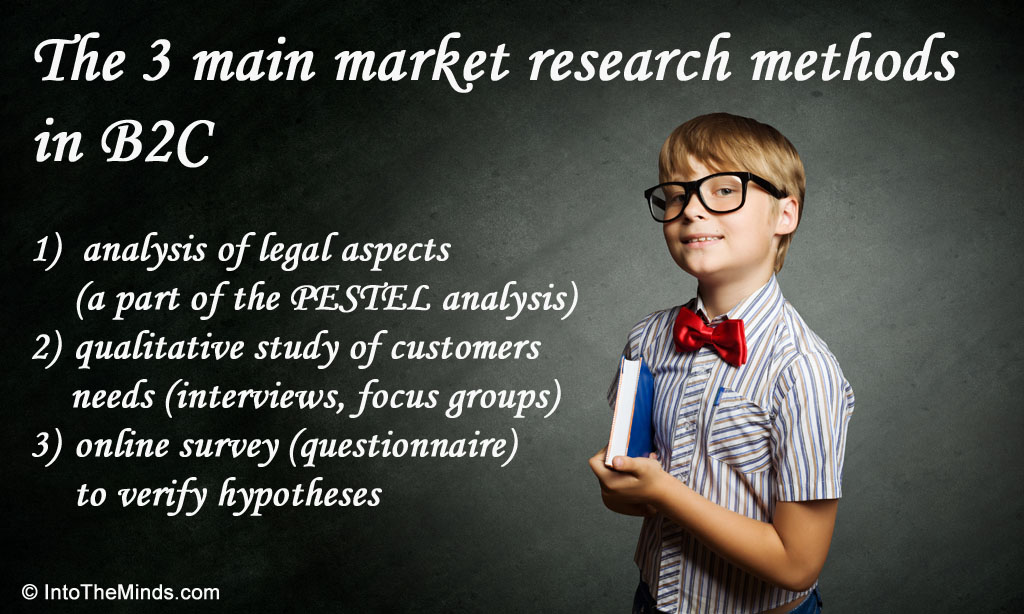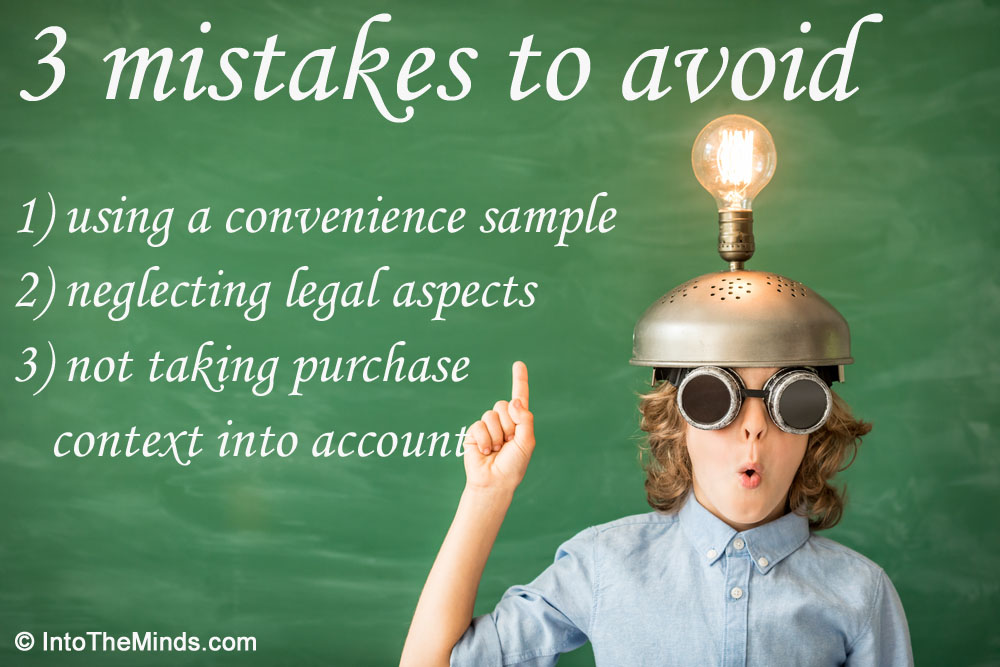The purpose of this article is to present the ins and outs of B2C market research with a particular focus on the methods used and the difficulties expected. While in our online market research guide, we have discussed all the techniques and tools available to carry out ideal market research, today we will modestly try to focus on a series of the minimum steps to be undertaken by would-be entrepreneurs, startups and more generally all companies wishing to launch a new product or service in B2C. The main question we will try to answer will, therefore, be: “What is the minimum that should be done in a B2C market research study when you have few resources?”.
Table of contents
- Definitions
- Market research methods for B2C
- Sequence to use the different methods
- 3 mistakes to avoid
- Specificities for market research for retail projects
Definitions of the terms
B2C refers to a market in which the company sells directly to a physical person, that is to say, what is commonly referred to as a “consumer”. Local shops (also known as “retailers”) are the very example of companies active in B2C.
B2C market research is the one that is most often (wrongly) summarised in online surveys. Market research in B2C is not limited to online questionnaires, and as we will see in the next paragraph, there are many other methodologies and techniques to apply, to obtain a result that is the factual reality of a market. Because the purpose of a market study is this: to determine what the facts of a market are and to use this accurate and realistic analysis as a basis to put all the chances on one’s side when launching a business.

Market research methods to be used in B2C
While the purpose of market research is to describe the reality of a market factually, it should be noted that this work can only be done by using several complementary methods. Too often we see that project leaders, entrepreneurs, but also marketing managers in larger companies, equate B2C market research with an online survey. Unfortunately, this is very simplistic. In this paragraph, we would like to give you an overview of the different market research methods that we consider most important in a B2C context, and in the next paragraph, we will suggest that you organise them to be as accurate as possible concerning the reality of a B2C market research.
Market research method n°1: the study of the B2C environment
Environmental research, particularly legal research, is particularly vital in B2C market research. Indeed, many rules, norms and standards protect the consumer. These rules can be regional, national, transnational (for example; European), and it is, therefore, crucial that you comply with them. The legal constraints analysis is part of a package called “environmental analysis” and is often known as PESTEL analysis. We want to refer you to the chapter of our white paper on this subject for a detailed explanation. In the context of your B2C project, it is therefore essential that you pay particular attention to the legal aspects. Of all the elements to be studied in the PESTEL analysis, it is therefore on the “L” of “Legal” that we advise you to spend the most time on. This is all the more important if you want to export your products or services, as standards may vary from one country to another within the European Union, and of course outside.
Where can you find information on the standards and legal constraints of your future market?
When entering a new market, it is entirely reasonable not to know everything. Surrounding yourself with the right experts ensures the long-term survival of your company. Legal mistakes are no excuse.
Before hiring a lawyer at great expense, take the time to clear the ground yourself. This will save you money of course, but above all, it will help you to become familiar with the material and develop your skills. The question then arises as to where to find the right information.
If nowadays everything is available on the Internet, we recommend that you make a very judicious selection of the information you need to find. Before you start fishing for information on the Internet, you must first meet with the following professionals:
- Entrepreneurship support organisations: they always have a legal department that will help you and provide you with relevant and above all reliable information. For France, contact your Chamber of Commerce and Crafts or BPI France. For Belgium, contact Brussels at Hub. Brussels (which now includes retail services as well as those supporting exports), Wallonia at AWEX, Flanders at Vlaio.
- Professional organisations: federations and other professional associations are a prime place to collect reliable information on a market. These organisations all have lawyers available to members, but who can be solicited in the context of launching an activity. Here are some useful links:
- The General Confederation of Retail Food
- Confederation of Crafts and Small Building Companies
- National Confederation of Crafts, Trades and Services
- This site offers a search engine by country and product type. Registration is free of charge.
Market research method 2: Interviewing consumers
As part of B2C market research, it is crucial to understand the needs of consumers, their expectations, but also their frustrations (known as “pain points”). We, therefore, propose that you use methods to qualify consumer needs. These methods are part of the qualitative marketing research that we have covered in detail in our online market research guide. In this article, we will, therefore, confine ourselves to giving a general overview of qualitative techniques for interviewing consumers. The two main methods are the qualitative interviews and the focus group (find here the differences between the two techniques)
The qualitative interview
Qualitative interviews can be conducted in different ways in B2C. Depending on the purchasing context, you may prefer face-to-face (for example at the consumer’s home) or in situ (for example, at the checkout) interviews.
Valuable advice
The purchasing context should guide you in choosing the right technique. In the case of impulse buying (in a local shop), you will have to focus on the in-situ context to be as close as possible to the purchase decision and collect the most reliable information possible. In more complex purchasing contexts (long-term equipment goods), face-to-face contact is ideally suited. Also, remember to include in the discussion all those involved in the decision. In the case of choosing an energy or Internet provider, it is not uncommon for the decision to be made within the couple, or even by including the needs of the children.
credits: Shutterstock
The focus groups
The focus group aims to bring together between 6 and 8 people in a room to discuss a specific topic. Participants will be recruited based on the suitability of their profile with future customers (the “targets”) of your product or service.
Focus groups are particularly popular in B2C (much less in B2B for practical reasons that we will discuss in the next article), as it is relatively easy to recruit individual consumers for this type of exercise.
The focus group presents some difficulties of which you should be aware.
First, the focus group requires you to discuss a specific topic. It is particularly suitable if you have a prototype, a particular idea or a new product to put in the hands of the participants for discussion. Keep in mind that the discussion will be significantly improved if you have concrete elements to present to the participants.
Second, the outcome of the focus group will depend significantly on the quality of the moderation, that is to say, your ability (if you are the one who is leading the discussion) to involve all the participants. It is essential to avoid at all costs that one or two participants dominate the debate.
How to carry out a qualitative study as a would-be entrepreneur?
It is not easy to do an excellent qualitative study when you are a project leader and have few resources. However, it is still possible if we roll up our sleeves.
The first thing to do is to test your idea with the people around you before asking their opinion of strangers. Use your network to convince these people (who will need to have the profile of your future customers) to give you some time. Take at least 30 minutes to interview them. If you don’t feel ready to meet them, start with telephone interviews.
Essential tips: prepare your questions in the form of an interview guide (all our tips for writing it can be found here). Always make sure to record your impressions and summarise the interview directly after it. This is where your memories will be most fresh. Moreover, honestly, if you don’t do it straight after the meeting, you are likely to stop doing it at all.
Market research method n°3: the online survey
The 3rd most popular method for conducting market research in B2C is of course online market research. The aim here is not to measure consumer satisfaction (although this might make sense to quantify the frequency of a “pain point” among consumers), but rather to accurately evaluate and validate the hypotheses you have formulated in the previous steps on a sufficiently large sample. It is also an opportunity to validate visual aspects of your offer: store layout, packaging, advertising, and so on, any element can be confirmed in the context of an online survey.
Drafting rules are required as for an online questionnaire:
- avoid ambiguous, convoluted wording that could lead to confusion
- focus on statements (“I buy organic products in specialised outlets, “I use my car every day to go to work”, “I go through a travel agency to go on holiday”)
- Be careful when measuring purchase intent: questions that involve behavioural change, purchase intent rather than proven behaviour, are particularly dangerous to handle and are a source of major errors in market research. Questions such as “I am ready to buy more products…”, “in the future, I plan to…”, “I would be ready to pay X€ for this product/service”, will give you at best-overestimated results, and at worst downright false results. The Human Being has a unique capacity to project himself into the future without changing his daily habits. If you can’t do otherwise than use a prospective question, be sure to use other questions on the same subject that will help you determine whether the consumer is telling the truth or is misleading. Once your online questionnaire is ready, do not forget to test it on a small sample to identify any problems and to have time to correct them, (this is called a “soft launch” and is usually done on 10% of the panel planned for the survey).
Renting a panel: an affordable way to conduct online market research
The recurring question we are asked as a market research agency is “where can I find the people to answer my questionnaire?”
We strongly advise you not to send this questionnaire to people you know. The results would be biased. Instead, invest (1000€ is more than enough for a sample of 200 to 400 people depending on the country) in renting an external panel on which to conduct your questionnaire.
Many companies rent panellists according to your needs. You will have to define selection criteria (age, sex, place of residence) before launching your online questionnaire. Our blog being strictly non-commercial, we will not advertise them here, but feel free to contact us for more information.
In which order should the different market research methods be used?
Our online market research guide provides you with a sequence in which you can use the different market research methods. This is, of course, an ideal master plan when the full range of market research techniques can be applied (which, let’s face it, rarely happens). In the more frequent case of saving of resources, we, therefore, advise you to use the 3 methods described above and proceed as follows:
- Determine precisely the legal constraints that your product/service will have to meet
- Spend time understanding what your catchment area will be and study your 3 main competitors
- interview about 20 people (for at least 30 minutes and if possible after having experienced your competitors), and determine in descending order of importance the 10 factors that determine satisfaction, loyalty and purchase.
- Prepare your quantitative survey: formulate 2 questions for each of these 10 factors, test your questionnaire on a small sample of 20 people and then start the process of administration with a minimum of 200 people.
- based on the answers obtained in the previous step, improve what needs to be improved in your product/service and return to step 4 (all the easier as you will have ensured that you keep the contact details of the people you interviewed and that you have obtained their consent to contact them again, Cf. GDPR).

Difficulties and points of attention in B2C market research: 3 mistakes to avoid
As in any market research study, those conducted in a B2C context require attention to specific issues.
Error #1: Use a convenience sample
There is nothing worse than using only a convenience sample for the qualitative (method 2) and quantitative (method 3) phases. You must absolutely seek to interview strangers who will have no emotional connection with you.
Error #2: neglect the legal aspects
Legal errors do not forgive. While errors in marketing or strategy analysis can always be corrected later on, those related to legal aspects are paid in cash and often retroactively.
Error #3: Misunderstand how the purchase decision is made
Your market research should focus on the context that determines the purchasing decision. If only one person makes the decision, you need to focus on that one person. If the decision is made by several people, you should interview all stakeholders in order to understand the decision-making process. If the context (internet / point of sale) conditions the purchase, you must get as close as possible to this context to conduct your market research.
The particularities of market research for retail outlets
Market research for a local business responds to a particular dynamic. The location of the point of sale often determines the success or failure of the company.
In addition to methods 1, 2 and 3, the study of the location of the point of sale must, therefore, be added. We have devoted an entire chapter of our online market research guide to this subject, to which we refer you.
Given the generally small size of the catchment area in the case of local shops, it is also appropriate to strengthen, in the context of qualitative interviews, the study of competition and the points of differentiation of the latter.
In any case, never start without finding the right location. Even with the best product in the world, customers may not come to you.
Posted in Marketing.
